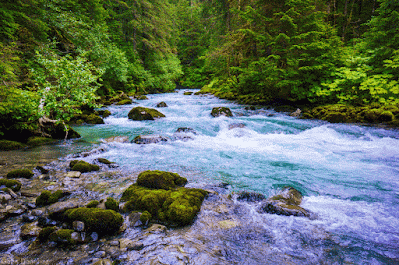Sources % of Total
- Ocean. 97.33
- Saline lakes and inland seas. 0.008
- Polar ice and glaciers. 2.4
- Ground water. 0.61
- Lakes. 0.009
- Soil moisture. 0.005
- Atmosphere water vapour. 0.001
- Rivers. 0.0001
Physical properties Water
Is is a colourless and tastless liquid. It's physical properties are given in article along with the physical properties of heavy water.
The unusual properties of water in the condensed phase (liquid and solid states) are due to the presence of extensive hydrogen bonding between water molecules. This leads to high freezing point high boiling point, high heat of vapourisation and high heat of fusion in comparison to H2S and H2Se. In comparison to other liquid, water has a higher specific heat, thermal conductivity, surface tension, dipole moment and dielectric constant, etc.
These properties allow water to play a key role in the biosphere. The high heat of vapourisation and heat capacity are responsible for moderation of the climate and body temperature of living beings.
It is an excellent solvent for transportation of ions and molecules required for plants and animals metabolism. Due to hydrogen bonding with polar molecules, even covalent Compounds like alcohol and carbohydrates dissolved in water.
Structure of Water
In the phase is bent molecules with a bond angle of 104.5°, and O-H bond length of 95.7 pm as shown.
It is a highly polar molecules. Its orbital overlap picture is shown in picture. In the liquid phase water molecules are associated together by hydrogen bonds.
The crystalline form of water is ice. At atmosphere pressure ice crystallises in the hexagon form, but at very low temperatures less condenses to cubic form. Density of ice is less than that of water. Therefore, an ice cube floats on water.
In winter season ice formed on the surface of a lake provides thermal insulation which ensures the survival of the aquatic life. This fact is of great ecological significant.
Hard and Soft water
Rain water is almost pure (may contain some dissolved gases from the atmosphere). Being a good solvent, when it flows on the surface of earth, it dissolves many salts. Presence of calcium and magnesium salts in the from of hydrogencarbonate, chloride and sulphate in water makes water 'hard water'. Hard water does not give lather with soap. Water free from soluble salts of calcium and magnesium is called Soft water. It gives lather with soap easily.
It is, therefore , unsuitable for laundry.It is he harmful for boilers as well, because of deposition of salts in the from of scale. This reduces the efficiency of the boiler. The hardness of water is of two types:
- Temporary hardness, and
- Permanent hardness











